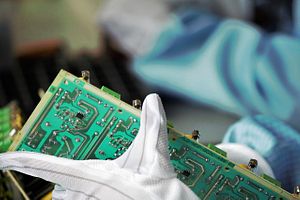Semiconductors are as ubiquitous as they are crucial to the modern economy and yet they are in short supply this year. In January, the world’s largest carmakers raised alarm bells about not having enough chips, but what looked to be isolated to one industry has enveloped more sectors in the weeks since – including TVs, mobile phones, video games, and PCs. Home to some of the world’s largest chipmakers, South Korea has so far been mostly unaffected by the shortfall in semiconductors, though major conglomerates are indicating their bottom line will take a hit soon.
The initial cause of the chip crunch can partly be traced to the auto industry. When COVID-19 first struck in early 2020 and precipitated a sharp fall in global demand, many of the world’s top automakers responded by cutting back on chip orders – needed for everything from infotainment systems to rearview cameras to even powering electric vehicles. With consumers spending more on personal electronics amid social distancing measures, these manufacturers quickly took advantage of the gap left by carmakers. When demand for autos rebounded in the second half of last year, car companies scrambled for new chip orders only to find long lead times as already overbooked chipmakers tried to increase production.
However, the global shortage is exacerbated by a series of other developments as well. Making semiconductors is highly capital-intensive, requiring large investments and time to scale up production. In the past few years, the overall demand for semiconductors has risen as new products are increasingly chip intensive compared to their predecessors, such as 5G phones and electric vehicles. Notwithstanding the expected challenges in meeting demand, there have also been several recent supply shocks. A cold snap in Austin, Texas in February temporarily shut down a major Samsung wafer processing factory; separate incidents of a fire and earthquake in Japan have disrupted production for a key supplier of semiconductors to the auto industry; and a drought in Taiwan is forcing the world’s largest chip manufacturer to slow output.
Most large South Korean conglomerates known as chaebol have weathered recent challenges much better than their global competitors, even benefitting from the situation, but that may change as early as this month. Through January and February South Korea exported $27.9 billion and $10.9 billion worth of semiconductors and autos, up 16 percent and 29 percent over the same period last year, respectively. Optimism in these top tier South Korean export industries, however, is waning.
The latest monthly business survey index from the Korea Economic Research Institute – measuring business sentiment, where a score above or below 100 reflects positive or negative outlook, respectively – shows upcoming market pessimism in autos and semiconductors. The market sentiment for autos in April dropped 11.4 points to 97.4 while electronics and telecommunication equipment, including chips, fell by 20.5 points to 90.
This comes on the heels of concerning announcements from the largest South Korean chaebol in each sector. Carmaker giant Hyundai announced this week that it would need to temporarily suspend production at its Ulsan plant of its Kona and electric-powered IONIQ 5 models due to lack of chips. The company had previously escaped this setback faced by many of its competitors because it maintained a large stockpile of semiconductors. Even though it is one of the world’s top chip manufacturers, Samsung also expects the shortage to cut into profits next quarter and even delay the launch of a new Galaxy Note smartphone.
More worrisome is the possibility that the troubles of these individual companies could pose at least a temporary challenge to South Korea’s strong economic recovery from the pandemic. While the government’s ability to effectively contain the virus at home certainly played a critical role in South Korea’s GDP contraction being the lowest among OECD countries last year, goods exports in the second half of the year were just as, if not more, important in helping the economy. Driving much of these exports were South Korean chaebols.
Though overall exports declined last year by over 5 percent, South Korean exports actually slightly increased as a percentage of the global market share. Exports of semiconductors, the country’s most lucrative export, were $159.6 billion in 2020, up nearly 4 percent from 2019. While auto exports fell by 12 percent last year, they still totaled $35 billion, remaining one of the country’s top exports. The year-over-year decline was also less than the estimated 15 percent drop in global auto sales. Electric vehicle production continues to be a small part of the auto industry in South Korea, but it helped soften last year’s decline with exports rising almost 66 percent.
It is too early to gauge how much large South Korean companies – and the domestic economy by extension – will suffer from the global dearth of semiconductors, though the shortage has all the makings of a potentially serious problem. Even so, the fact that automakers expect their issues to clear up in the second half of 2021 and some chip plants that were temporarily forced to suspend operations have reopened provide sufficient reason to believe any setbacks will be relatively short-lived.

































